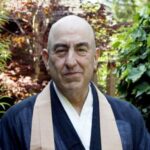Buddha Mind, Buddha Body
By Thich Nhat Hanh
Parallax Press, 2007
150 pages; $14.95 (paperback)
Thich Nhat Hanh wears simple brown robes and serves the world as a monk, Zen teacher, activist, scholar, poet, a bridge among the world’s faiths, and a kind of revolutionary. Like Walt Whitman, he could say in good faith, “I contain multitudes.” But then he would no doubt assert that we all contain multitudes. For thirty years, Thich Nhat Hanh (or Thay, as students respectfully and familiarly call him) has been cultivating the ground of Buddhism in the West. I like Richard Baker’s description of him, quoted in Being Peace: he is “a cross between a cloud, a snail, and piece of heavy machinery-a true religious presence.”
In the 1980s Thich Nhat Hanh’s audience was a relatively small circle of peace activists and Zen students who were just acquainting themselves with the notion of “engaged Buddhism,” forged in the 1950s and ’60s by Thay and others in Vietnam’s sea of fire. Twenty-two years and several wars later, he is among the best-known and most influential Asian Buddhist teachers in the world. His practice and retreat centers in France, California, and Vermont are popular and busy. Hundreds of local sanghas flourish under the umbrella of the Community of Mindful Living, which supports his teachings. Thousands consider him their teacher, and millions have read his books-more than one hundred titles in English alone. At the age of eighty, he continues to translate, interpret, and promote dharma teachings day and night, challenging us to look deeply at ourselves and at the societies we create.
Early on I read Thich Nhat Hanh’s A Guide to Walking Meditation and practiced it on slow walks around Oakland’s Lake Merritt. I recall two passages from that book. In one, he writes, “Some people say that only walking on burning coals or walking on spikes or on water are miracles, but I find that simply walking on the earth is a miracle.” In another, he explains that the dharma encompasses everything, joy and suffering:
The true face of our essential nature is also the swamp and muddy waters of greed, hatred, and ignorance. Truth is also suffering and the hurt we human beings inflict on each other…when we look more deeply, we can understand that the birdsong also bears a trace of suffering.
Thich Nhat Hanh’s latest book from Parallax Press is Buddha Mind, Buddha Body. Parallax is the publishing house he began with Arnold Kotler in 1987, now a nonprofit project of the Community of Mindful Living, and it has become the primary purveyor of teachings by Thich Nhat Hanh and other works of engaged Buddhism. I think of Buddha Mind, Buddha Body as a first-class work of modern Buddhist psychology. Not surprisingly, it begins with the practice of mindful walking.
When you practice slow walking meditation alone, you may like to try this: Breathe in and take one step, and focus all your attention on the sole of your foot. If you have not arrived fully, one hundred percent in the here and the now, don’t make the next step. You have the luxury of doing this. Then when you’re sure that you’ve arrived one hundred percent in the here and the now, touching reality deeply, then you smile and you make the next step. When you walk like this, you print your stability, your solidity, your freedom, your joy on the ground.
Buddha Mind, Buddha Body is part of Thich Nhat Hanh’s continuing exploration of the Vijnaptimatra, or Manifestation-only school of Buddhism, drawing from the Lankavatara Sutra and from the teachings of the fifth-century proto-Mahayana master Vasubhandu. Thay’s earlier book, Understanding Our Mind-a translation of and commentary on Vasubhandu’s “Fifty Verses on the Nature of Consciousness”-covers related ground in the Mind-only school, known as Yogachara or Vijnanavada.
Where the earlier volume was technical, Buddha Mind, Buddha Body is thoroughly accessible, with Thich Nhat Hanh’s uncanny knack for unpacking complex matters of Buddhist doctrine in everyday terms. It is not accidental that he begins with the practice of mindful walking. Mindfulness has always been the very center of his teaching, but as the Buddha himself taught, there is no gap between mind and body. How we walk, how we touch the earth, how we sit, how we act with each other is our co-creation of mind and body. When Thich Nhat Hanh speaks of “interbeing,” he is speaking simultaneously about intimacy with our body and with the unknowable, interweaving complexity of our societies.
Thich Nhat Hanh’s teachings aim at the heart of our beliefs and illusions. The Order of Interbeing, which Thay established in 1966, is guided by fourteen mindfulness trainings. The very first says:
Aware of the suffering created by fanaticism and intolerance, we are determined not to be idolatrous about or bound to any doctrine, theory, or ideology, even Buddhist ones. Buddhist teachings are guiding means to help us learn to look deeply and to develop our understanding and compassion. They are not doctrines to fight, kill, or die for.
We must see through our fear, never rejecting what is part of us, nor empowering our beliefs. This understanding, so thoroughly explored in Buddha Mind, Buddha Body, contains an insight that leads to nonviolence:
Meditation is grounded in the insight of nonduality-nonduality between good and evil, suffering and happiness. So the method of handling our suffering is always nonviolent. When you accept the nondualistic nature of reality, your way becomes nonviolent. You don’t feel the need to fight against your anger or your fear anymore, because you see that your anger and your fear are you. So you try to handle them in the most tender way. There’s no fighting anymore. There’s only the practice to transform and to take care.
Thich Nhat Hanh describes the paramitas as “six techniques for happiness.” Paramita means “from this shore you go to the other shore.” I have always felt that Thay’s teachings strongly embodied the paramitas of kshanti, inclusiveness or patience, and virya, diligence or effort. It takes incredible diligence to build the lay and monastic communities that Thich Nhat Hanh has nurtured in the West, to write the many books he has written, to lecture and teach as widely and publicly as he has for twenty-five years, and to endure forty years of exile from his homeland, which ended only two years ago. More than that, it takes effort to turn toward the world’s suffering with understanding and without flinching.
Kshanti, inclusiveness, goes hand in hand with diligence. Inclusiveness, Thay explains, is “the practice of helping your heart to grow larger and larger all the time.” Just as Martin Luther King Jr. taught about Christ’s teaching of agape, Thich Nhat Hanh teaches that inclusiveness means:
…embracing everyone, everything, you don’t exclude anyone. In true love, you don’t discriminate anymore. Whether that person is white or black or yellow, whether he is a Muslim, a Buddhist, a Jew, a communist, you accept them all with no discrimination whatsoever. Inclusiveness here means non-discrimination.
Thich Nhat Hanh understands Buddhism as a way to be fully human, to walk the earth in peace, making peace. This kind of existence is far beyond any particular religious school or denomination, valuing humanness above all doctrines and ideology. Yet he recognizes that the great religions have a responsibility to lead people on this path. I note that Riverhead Books has just released a tenth-anniversary issue of Thich Nhat Hanh’s Living Buddha, Living Christ, a book that points to the common ground shared by Buddhism and Christianity. With a new introduction by the noted author and scholar Elaine Pagels, the book is another milestone of Western dharma, even more timely now than when it was originally published. The essence of this book, of all Thich Nhat Hanh’s books, is dialogue, sharing ourselves, something we need now more than ever, across all faiths. This is how to nourish our communities and ourselves.
When Buddhists and Christians come together, we should share a meal in mindfulness as a deep practice of Communion…When we practice this way, every meal is the Last Supper. In fact, we could call it the First Supper, because everything will be fresh and new.

